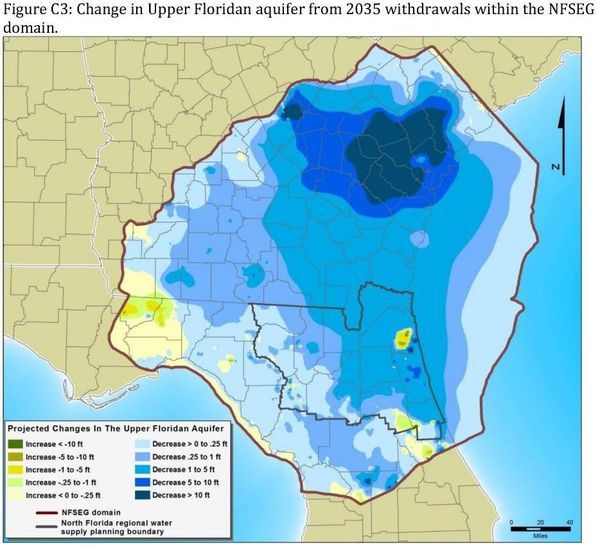This public hearing for a wastewater permit far away from the Suwannee River Basin
is of interest because apparently the instigator of this biomass plant
is also the president of Twin Pines Minerals, which
wants to strip mine for titanium far too near the Okefenokee Swamp.
When:
7 PM, Tuesday, March 2, 2021
Where:
https://gaepd.zoom.us/j/96881364173
![[Property Location]](https://www.wwals.net/pictures/2021-03-02--grp-wastewater-npdes-permit-hearing/ga-epd-permit-application-0051.jpg)
Property Location
PUBLIC NOTICE
Notice of Application for National Pollutant Discharge Elimination System Permit to
Discharge Treated Wastewater Into Waters of the State of Georgia.
The Georgia Environmental Protection Division has received a new
NPDES permit application for the issuance of a new NPDES permit.
Having reviewed such application, the Environmental Protection
Division proposes to issue for a maximum term of five years the
following permit subject to specific pollutant limitations and
special conditions:
GRP Madison Renewable Energy Facility, LLC, P.O. Box 909, Colbert,
Georgia 30628, NPDES Permit No. GA0050283, for its steam electric
facility located at 268 Office Drive, Colbert, Georgia 30628. A
maximum of 3.55 MGD treated boiler blowdown, boiler feedwater,
boiler area drains, reverse osmosis reject water, STG sump area
drains, cooling tower blowdown, and stormwater is discharged to an
unnamed tributary to Beaverdam Creek in the Savannah River Basin.
EPD will host a public hearing via Zoom software at 7:00 p.m. on
March 2, 2021. Zoom is a free web conferencing platform that also
allows participation by phone. In accordance with EPD’s safety
precautions regarding the COVID-19 virus, EPD encourages members of
the public to participate in the public hearing via Zoom. The
purpose of the public hearing is to receive comments on the draft
NPDES permit for GRP Madison Renewable Energy Facility, LLC.
To log into the public hearing on your computer, please click this
link or copy and paste it into
your browser to join the meeting:
https://gaepd.zoom.us/j/96881364173
To ensure that you are ready to participate when the meeting begins,
we recommend that you
download Zoom in advance. Zoom can be found here:
https://zoom.us/
To dial in by phone, please call this number: 1-470-381-2552
The meeting ID is 968 8136 4173
The passcode is 572750
Please note that if you choose to participate by phone, your number
may be visible to other meeting attendees.
The public hearing is a formal process to Continue reading →
![[Pictures by Gretchen Quarterman from 2018 festival]](https://www.wwals.net/pictures/2022-04-23--day-in-the-woods/many.jpg)

![[John Quarterman stands by the Withlacoochee River in Georgia. Matt Odom / for NBC News]](https://www.wwals.net/pictures/2021-06-08--gates-algae-nbc/210604-john-quarterman-mn-1635.jpg)
![[Notice, Region and Assessment]](https://www.wwals.net/pictures/2021-04-15--ssrwpc/many.jpg)
![[Property Location]](https://www.wwals.net/pictures/2021-03-02--grp-wastewater-npdes-permit-hearing/ga-epd-permit-application-0051.jpg)

![[2019-04-03 White Sulfur Spring Flowing]](https://www.wwals.net/pictures/2016-12-12--djprice-nfrwsp/2019-04-03--white-sulfur-spring-flowing.jpg)

![[Old Trails]](https://www.wwals.net/pictures/2020-11-02--trail-marker-trees/trails.jpg)
![[1838 Motte Seminole War trail map]](https://www.wwals.net/pictures/2020-11-02--trail-marker-trees/1838-motte-seminole-war-trail-map.jpg)
![[Trailmarker Trees, How To, and old map]](https://www.wwals.net/pictures/2020-11-02--trail-marker-trees/many.jpg)
![[Tannin Times, WWALS monthly newsletter]](https://www.wwals.net/pictures/2020-11-01--tannin-times/tannin-times.jpg)
![[Graph 93-percent-AGAINST 10 14 20-0001]](https://www.wwals.net/pictures/2020-10-19--m-cores/Graph_93-percent-AGAINST_10_14_20-0001.jpg)